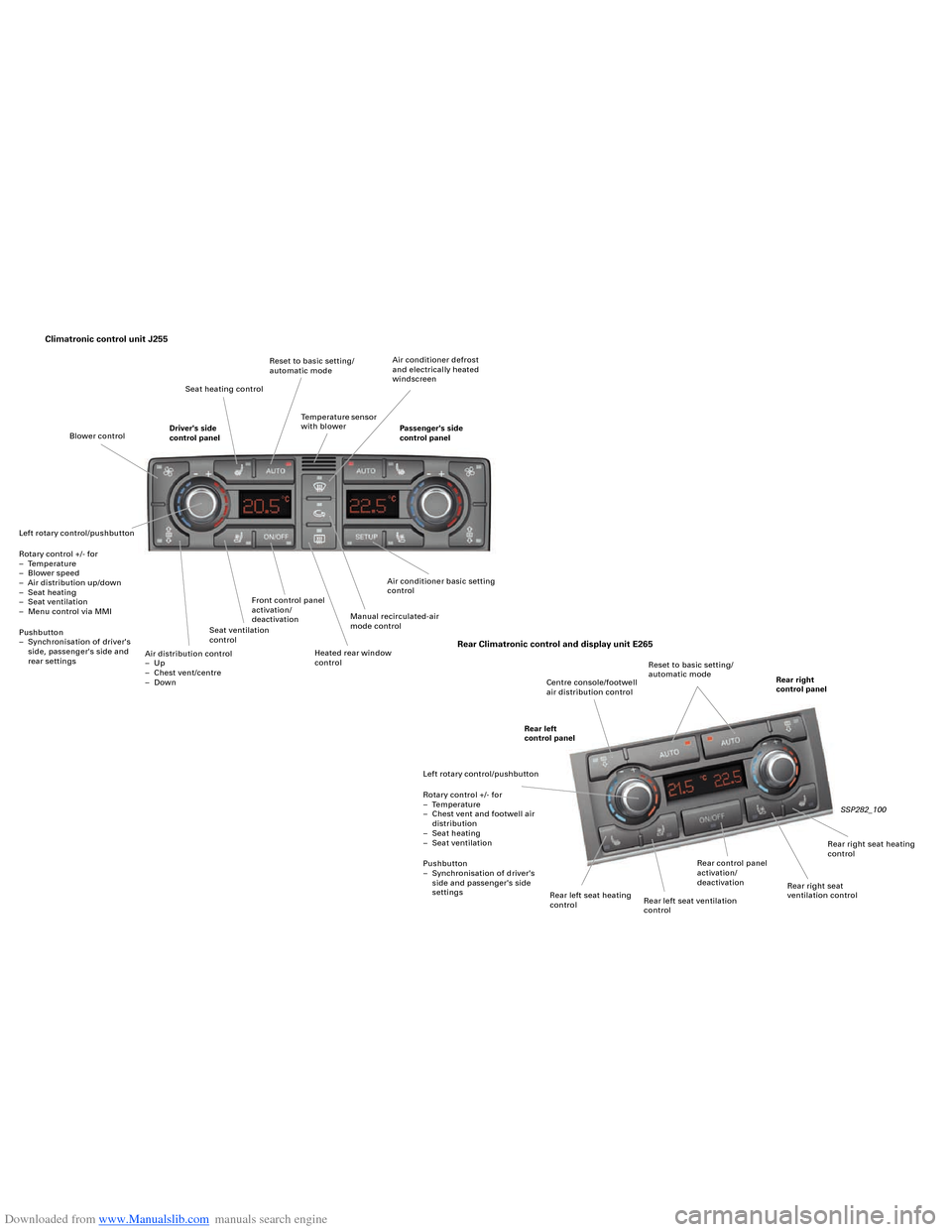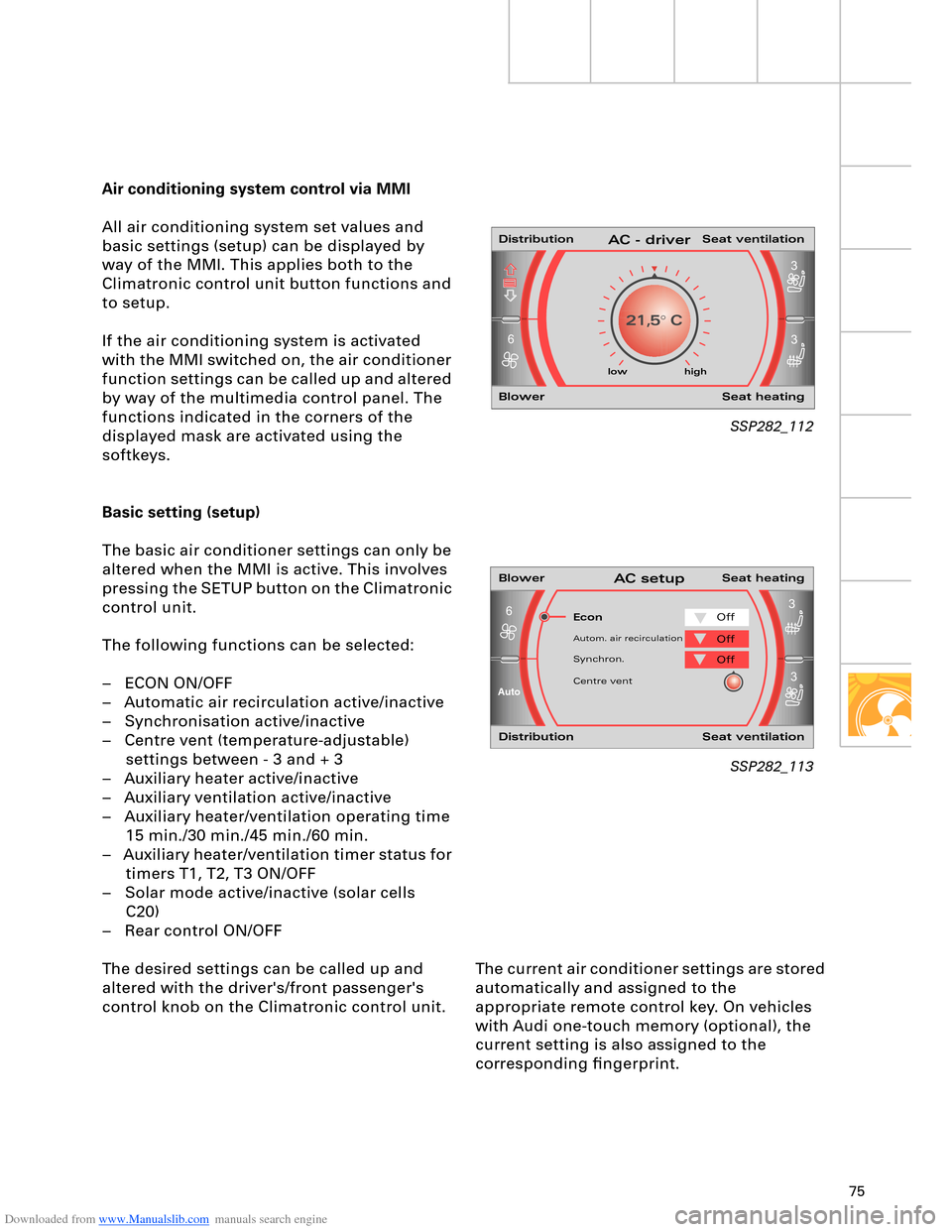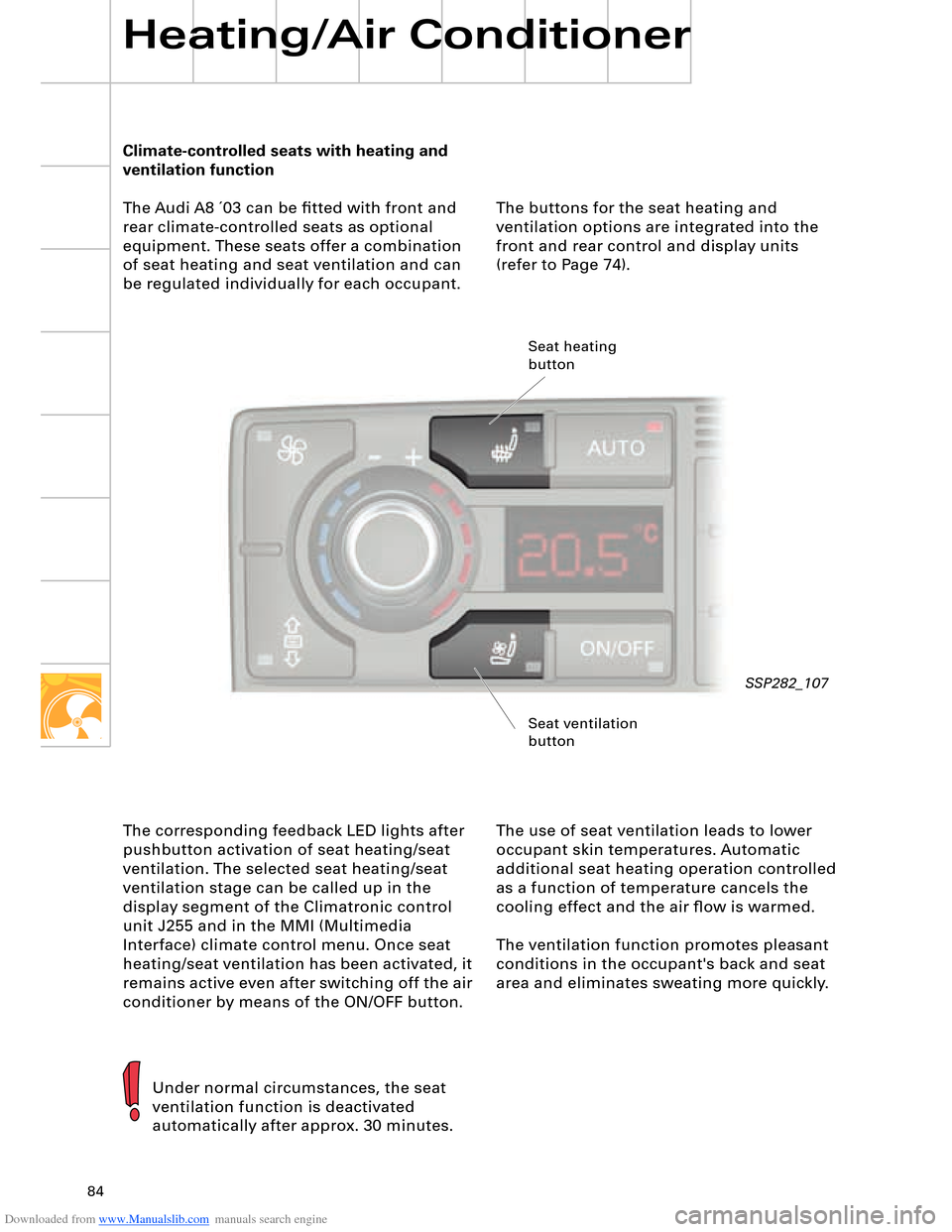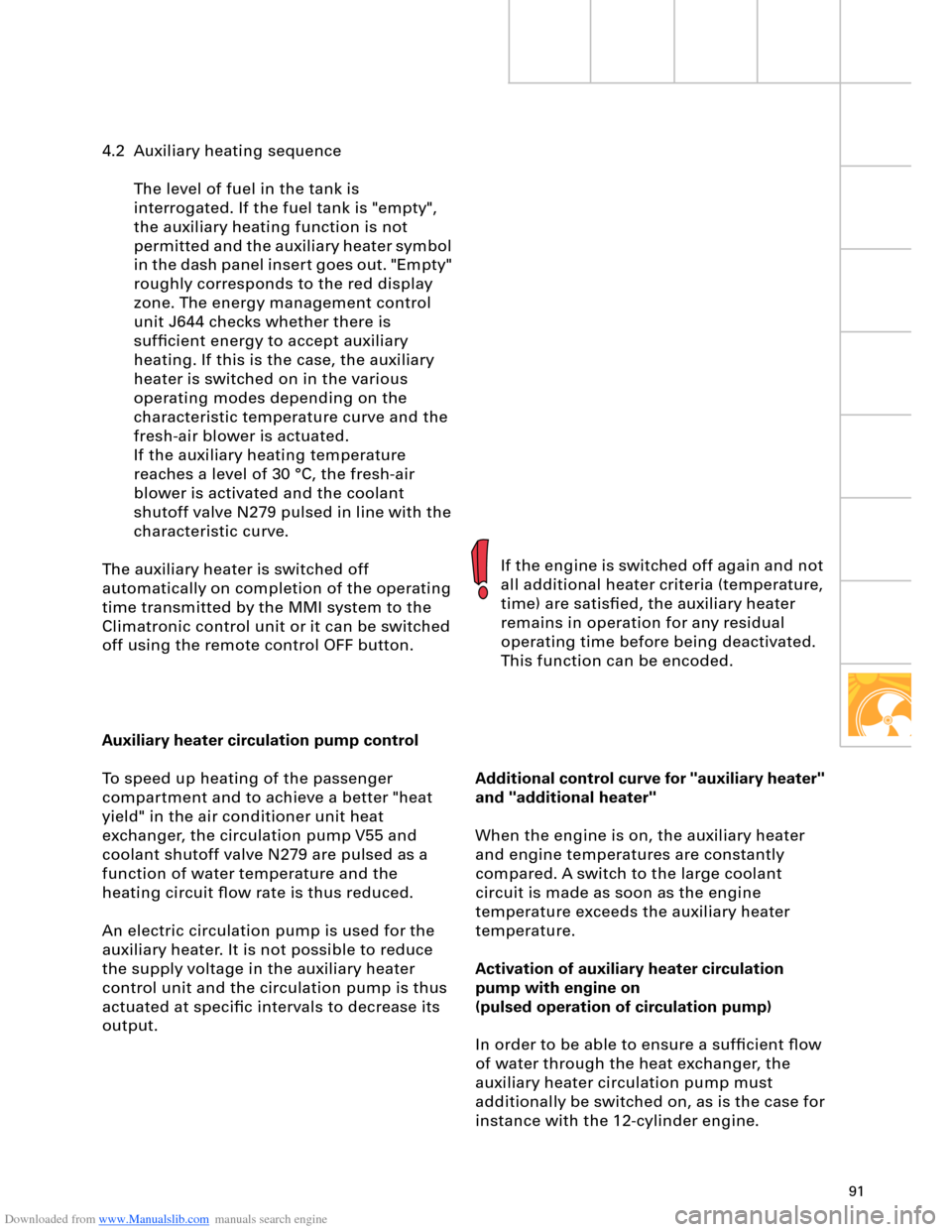Butto AUDI A8 2003 D3 / 2.G Technical Features Manual
[x] Cancel search | Manufacturer: AUDI, Model Year: 2003, Model line: A8, Model: AUDI A8 2003 D3 / 2.GPages: 96, PDF Size: 5.51 MB
Page 73 of 96

Downloaded from www.Manualslib.com manuals search engine 7374
A distinction is made between two air
conditioner unit versions
– 2-zone front and rear climate
control
– 4-zone front and rear climate
control
and three types of control and
display unit
– Air conditioner control panel with
no seat heating/ventilation
– Air conditioner control panel with
seat heating
– Air conditioner control panel with
seat heating and seat ventilation
(identified by part number index).
SSP282_099
Self-diagnosis
Fault diagnosis and measured value blocks
for air conditioner and seat heating system
can be read out by way of address words 08
"Air conditioner/heater electronics" and 28
"Rear climate control". The functions of and
exact procedure for self-diagnosis and
assisted fault-finding with VAS 5051 can be
found in the Heating/Air Conditioner
Workshop Manual for the relevant vehicle
model.
Operating principle
When the ignition is switched on, the
Climatronic control unit J255 starts up with
the same temperature, air distribution and
fresh-air blower speed settings etc. as were
applicable the last time the ignition was
switched off by way of the appropriate key or
using fingerprint recognition.
If fingerprint recognition has been
implemented, this has priority over key
recognition (refer also to SSP 287 – Audi A8 ´03
Electrical Components).
Personalised settings
The following settings can be made for each
climate control zone (front left, right and,
optionally, with 4-zone climate control rear left
and right):
– Left/right temperature
– Air flow
– Left/right air distribution
– Left/right seat heating
– Left/right seat ventilation
– Operating modes (AUTO for driver and front
passenger, temperature-adjustable centre
vents, automatically controlled
recirculated-air mode, ECON)
The heated windscreen can be activated by
way of the air conditioner defrost button or
the air conditioner control unit automatically
switches on the electric heated windscreen if
the appropriate conditions are satisfied
(windscreen defrost or automatic mode on
cold starting).
The Climatronic J255 and heated windscreen
J505 control units communicate by way of the
LIN bus. The Climatronic control unit transmits
the specified windscreen heating power to the
heated windscreen control unit on the LIN bus.
Heating/Air Conditioner
Key recognition takes place in the case of
remote control (radio or key transponder),
with the driver identification control unit
providing the Climatronic control unit J255
with the appropriate information by way of
the CAN bus.
The electrically heated windscreen is only
supplied with the amount of power which can
currently be drawn from the electrical system
without draining the battery. This is
monitored by the energy management
control unit J644.
As is the case with the Audi A4, the
windscreen is heated by applying voltage to a
metallic foil fitted in the glass (refer to
SSP 213).
As in the Audi A4, the air conditioner
compressor is regulated as a function of load
and controlled externally by way of the
compressor regulating valve (refer to
SSP 240). The Climatronic control unit J255 is
connected to the convenience CAN, via
which diagnosis is also performed.
A manual air conditioning system is not
available.
Page 74 of 96

Downloaded from www.Manualslib.com manuals search engine Climatronic control unit J255
SSP282_100
Rear Climatronic control and display unit E265
Air conditioner basic setting
control
Heated rear window
control Front control panel
activation/
deactivation
Seat ventilation
control
Air distribution control
– Up
– Chest vent/centre
– Down Left rotary control/pushbutton
Rotary control +/- for
– Temperature
– Blower speed
– Air distribution up/down
– Seat heating
– Seat ventilation
– Menu control via MMI
Pushbutton
– Synchronisation of driver's
side, passenger's side and
rear settingsDriver's side
control panelPassenger's side
control panel Seat heating controlReset to basic setting/
automatic mode
Temperature sensor
with blowerAir conditioner defrost
and electrically heated
windscreen
Manual recirculated-air
mode control Blower control
Rear left
control panelCentre console/footwell
air distribution controlReset to basic setting/
automatic mode
Rear right
control panel
Left rotary control/pushbutton
Rotary control +/- for
– Temperature
– Chest vent and footwell air
distribution
– Seat heating
– Seat ventilation
Pushbutton
– Synchronisation of driver's
side and passenger's side
settings
Rear left seat heating
controlRear control panel
activation/
deactivation
Rear right seat
ventilation controlRear right seat heating
control
Rear left seat ventilation
control
Page 75 of 96

Downloaded from www.Manualslib.com manuals search engine 75
3
36
Auto
21,5° C
63
3
The current air conditioner settings are stored
automatically and assigned to the
appropriate remote control key. On vehicles
with Audi one-touch memory (optional), the
current setting is also assigned to the
corresponding fingerprint. Air conditioning system control via MMI
All air conditioning system set values and
basic settings (setup) can be displayed by
way of the MMI. This applies both to the
Climatronic control unit button functions and
to setup.
If the air conditioning system is activated
with the MMI switched on, the air conditioner
function settings can be called up and altered
by way of the multimedia control panel. The
functions indicated in the corners of the
displayed mask are activated using the
softkeys.
Basic setting (setup)
The basic air conditioner settings can only be
altered when the MMI is active. This involves
pressing the SETUP button on the Climatronic
control unit.
The following functions can be selected:
– ECON ON/OFF
– Automatic air recirculation active/inactive
– Synchronisation active/inactive
– Centre vent (temperature-adjustable)
settings between - 3 and + 3
– Auxiliary heater active/inactive
– Auxiliary ventilation active/inactive
– Auxiliary heater/ventilation operating time
15 min./30 min./45 min./60 min.
– Auxiliary heater/ventilation timer status for
timers T1, T2, T3 ON/OFF
– Solar mode active/inactive (solar cells
C20)
– Rear control ON/OFF
The desired settings can be called up and
altered with the driver's/front passenger's
control knob on the Climatronic control unit.
SSP282_112
SSP282_113
low high
Econ
Distribution Seat ventilation
Blower Seat heatingAC - driver
Blower Seat heatingAC setup
Distribution Seat ventilation
Off
Autom. air recirculationOff
Synchron.Off
Centre vent
Page 84 of 96

Downloaded from www.Manualslib.com manuals search engine 84
The buttons for the seat heating and
ventilation options are integrated into the
front and rear control and display units
(refer to Page 74). Climate-controlled seats with heating and
ventilation function
The Audi A8 ´03 can be fitted with front and
rear climate-controlled seats as optional
equipment. These seats offer a combination
of seat heating and seat ventilation and can
be regulated individually for each occupant.
Heating/Air Conditioner
The corresponding feedback LED lights after
pushbutton activation of seat heating/seat
ventilation. The selected seat heating/seat
ventilation stage can be called up in the
display segment of the Climatronic control
unit J255 and in the MMI (Multimedia
Interface) climate control menu. Once seat
heating/seat ventilation has been activated, it
remains active even after switching off the air
conditioner by means of the ON/OFF button.The use of seat ventilation leads to lower
occupant skin temperatures. Automatic
additional seat heating operation controlled
as a function of temperature cancels the
cooling effect and the air flow is warmed.
The ventilation function promotes pleasant
conditions in the occupant's back and seat
area and eliminates sweating more quickly.
Under normal circumstances, the seat
ventilation function is deactivated
automatically after approx. 30 minutes.
SSP282_107 Seat heating
button
Seat ventilation
button
Page 91 of 96

Downloaded from www.Manualslib.com manuals search engine 91
4.2 Auxiliary heating sequence
The level of fuel in the tank is
interrogated. If the fuel tank is "empty",
the auxiliary heating function is not
permitted and the auxiliary heater symbol
in the dash panel insert goes out. "Empty"
roughly corresponds to the red display
zone. The energy management control
unit J644 checks whether there is
sufficient energy to accept auxiliary
heating. If this is the case, the auxiliary
heater is switched on in the various
operating modes depending on the
characteristic temperature curve and the
fresh-air blower is actuated.
If the auxiliary heating temperature
reaches a level of 30 °C, the fresh-air
blower is activated and the coolant
shutoff valve N279 pulsed in line with the
characteristic curve.
The auxiliary heater is switched off
automatically on completion of the operating
time transmitted by the MMI system to the
Climatronic control unit or it can be switched
off using the remote control OFF button.
Auxiliary heater circulation pump control
To speed up heating of the passenger
compartment and to achieve a better "heat
yield" in the air conditioner unit heat
exchanger, the circulation pump V55 and
coolant shutoff valve N279 are pulsed as a
function of water temperature and the
heating circuit flow rate is thus reduced.
An electric circulation pump is used for the
auxiliary heater. It is not possible to reduce
the supply voltage in the auxiliary heater
control unit and the circulation pump is thus
actuated at specific intervals to decrease its
output.
Additional control curve for "auxiliary heater"
and "additional heater"
When the engine is on, the auxiliary heater
and engine temperatures are constantly
compared. A switch to the large coolant
circuit is made as soon as the engine
temperature exceeds the auxiliary heater
temperature.
Activation of auxiliary heater circulation
pump with engine on
(pulsed operation of circulation pump)
In order to be able to ensure a sufficient flow
of water through the heat exchanger, the
auxiliary heater circulation pump must
additionally be switched on, as is the case for
instance with the 12-cylinder engine.If the engine is switched off again and not
all additional heater criteria (temperature,
time) are satisfied, the auxiliary heater
remains in operation for any residual
operating time before being deactivated.
This function can be encoded.